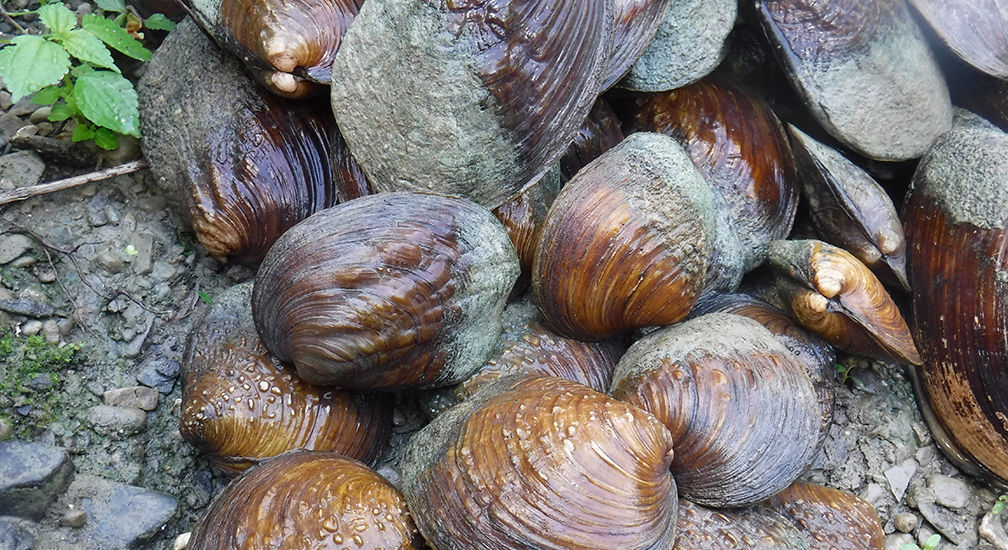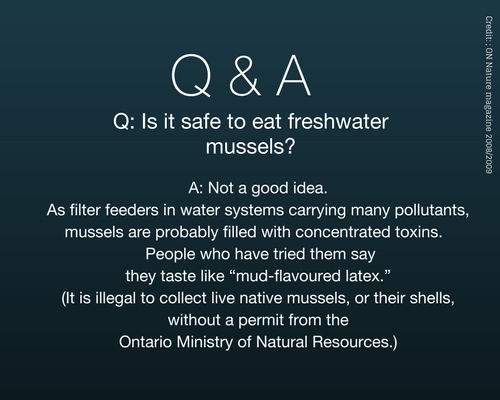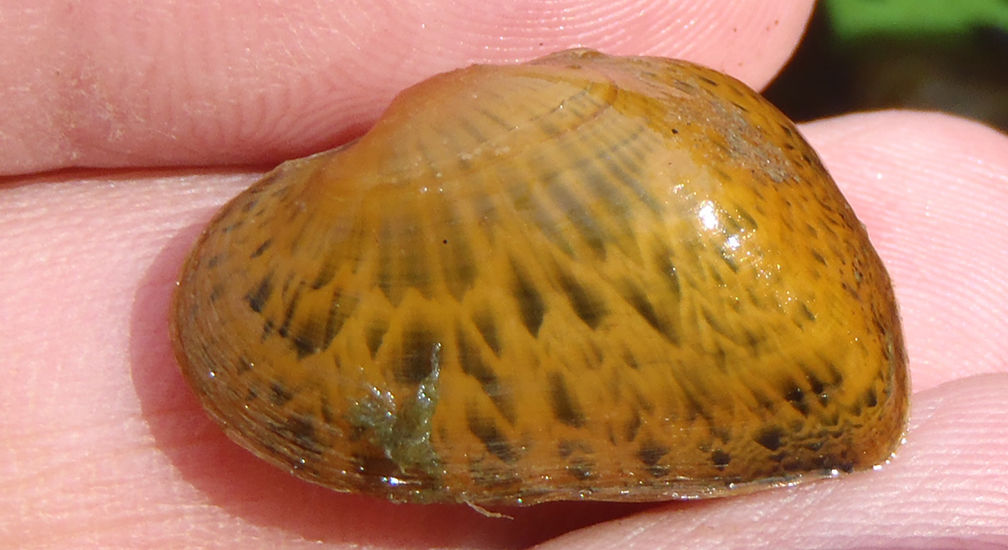Ontario Nature Blog
Receive email alerts about breaking conservation
and environmental news.
© Lora Denis
Mussels © Stephanie Muckle
Wartyback, snuffbox, round pigtoe, pocketbook… no, we haven’t gone crazy. These are just a few of the 41 wild and weird freshwater mussel species found in Ontario.
Hidden at the bottom of rivers and lakes and nestled under a layer of sand, these native molluscs often go unnoticed. But don’t let their odd names and rock-like appearances fool you. They play a significant role in keeping aquatic habitats healthy.

Todd Morris, a research scientist with Fisheries and Oceans Canada, explains that mussels perform many vital functions in aquatic ecosystems. A single mussel can filter approximately 40 litres of water each day, consuming large quantities of bacteria and algae, and leaving behind clearer, more habitable water for other aquatic species.

This ability to accumulate toxins makes them vulnerable to pollution and habitat changes. By monitoring mussels we can determine the state of our rivers and lakes. Healthy mussel populations are indicative of healthy watersheds!
In July, we joined Fisheries and Oceans Canada to conduct a mussel survey on Ontario Nature’s Sydenham River Nature Reserve.

“The Sydenham River is a special place for mussels,” says Morris, “the waterway running through Ontario Nature’s property contains as many as 32 species per square meter, many of which are species at risk, including the northern riffleshell, wartyback and snuffbox.”

Here’s something else that few people know: mussels are parasites. They must find a suitable host fish in order to reproduce and complete their life cycle, explains Morris.
Some mussels put on displays to lure hosts, mimicking small bait-like fish, while others release their larvae, or glochidia, into the water where the glochidia attach to a host fish as it swims by.
The snuffbox and northern riffleshell reproduce a little differently. Using their shell, they grab an appropriate fish by the head and release their glochidia onto it while it is trapped. This is called host capture. The glochidia develop within cysts on the fish’s gills and drop off when they become juvenile mussels.
The close connection between freshwater mussels and fish necessitates a holistic approach to mussel conservation. When we protect freshwater mussels, we are also protecting our native fish species and the quality of our Ontario’s waterways.
Next time you’re out exploring, try using Fisheries and Ocean’s Canada’s Clam Counter app to help identify and submit your mussel findings!

Gananoque Lake Nature Reserve © Smera Sukumar
I wonder what type the mussels described in ojbwe/odaawa mythology are. They are described as sacred cultural leaders. They are used in religious mide ceremonies and i have pictures of them. Do you have any idea about it?
What about petrified mussels? Probably they are pre-ice-age? Was the land covered by lakes also pre-last-ice-age that you know?
Thank you.
I live in apsley ont I was wondering my son i were swimming in Chandos lake and we seen fresh water mussels r u able to eat them if someone could lit me know thank u.
Hello,
It is advised not to eat Ontario freshwater mussels for several reasons; 1) As filter feeders they carry many pollutants 2) They can often taste like “mud-covered latex” 3) It is illegal to collect live mussels in Ontario without a permit from the MNRF
This information is also available in a graphic in the blog here: https://ontarionature.org/wild-weird-world-mussels-blog/
Genuine thanks for asking, caring about and helping to protect wild species and natural areas!
– Noah
Hey Julie Barry,
If you have a smartphones get iNaturalist app. It’s amazing and your observations will contribute to a growing body of knowledge
Dave
I live in southern Ontario very near Lake Erie. There’s a small lake near my home that is partially or perhaps entirely spring-fed. It is human-made, and probably has existed for at least 60 years, if not longer. The lake is full of various aquatic plants but I have found it very difficult to find a source of information that can help me to identify them. There are various sites online, and they are helpful but I’d like a more reliable, and ready source of info. Can you recommend a good book? There’s one called “Wetland Plants of Ontario.” How useful would that book be to me? Looking for specific names of plants online has proved really challenging. Thanks! Would that plant ID app work for aquatic plants?
Hello Cali,
I am a member of Ontario Nature and wish to ask about a mussel in our cottage lake-Crystal Lake. I have seen them for a few years at least snorkelling but there are slightly more now. They grow to 4-6 inches. They cannot be Zebra mussels given the size but from pictures of the latter look somewhat like them. They certainly seem to devote their energy and resources to growth instead of reproduction. I have also noticed this year what appear to be mystery snails, likely Chinese, so invasive species are starting. Do you have any idea what type they might be?
Sincerely,
Brad Vowins
Hi Brad,
Ontario has many species of mussels, but unfortunately as you noted some non-native species are invasive and detrimental to our aquatic systems.
Zebra mussels can reach up to 4 cm in length and the quagga mussel is also invasive in Ontario and has established itself in Lake Ontario and some of Ontario’s watersheds after introduction.
Does the mussel in question happen to look like either of the ones pictured in the attached document? https://www.crca.ca/wp-content/uploads/PDFs/LakeReports/Appendix5-InvasiveSpecies.pdf
Kind regards,
ON Noah